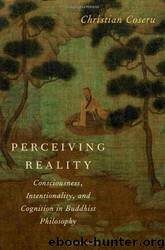Perceiving Reality: Consciousness, Intentionality, and Cognition in Buddhist Philosophy by Christian Coseru

Author:Christian Coseru [Coseru, Christian]
Language: eng
Format: epub
Tags: Philosophy, General, Epistemology, Religion, Mind & Body, Eastern, Buddhism
ISBN: 9780199843381
Publisher: Oxford University Press
83. TS 1242: pratyakṣam kalpanāpoḍhaṃ vedyate tiparisphutam/ anyatrāsaktamanasāpy akṣair nīlādivedanāt.
-170-
one abides calmly in oneself. In this state, a cognition is born from the senses [and]
is seen by the mind as form. [When] thoughts gradually return, one [is capable] of
identifying one’s own conceptual elaborations [and recognize] that the previous con-
ceptual state did not come from the senses.84
Dharmakīrti argues for the existence of nonconceptual states on phenomenological rather than logical grounds. He defends the notion that perception is a form of nonconceptual sensing in which there is cognitive awareness but no interpretation of, or judgment based on, the contents of this awareness. Through a process similar to the Husserlian epoché, perceptual judgments and conceptualizations are apprehended as constituting an overlapping cognitive layer that obscures the contents of the perceptual awareness.
It should be noted, however, that ordinary experience is not transparent with regard to the content of awareness and thus cannot serve as evidential ground for establishing dissimilarity between perception and conception. Just as the phenomenological bracketing affords an awareness of the interdependent nature of object apprehension (in other words, an awareness that cognition reveals an intentional relation to the object rather than establishes a connection with a putatively external or internal object), so also in the Buddhist tradition the detached awareness by means of which one attends to phenomena directly and without any mediation reveals the secondary order character of conceptual elaborations. Citing Dharmakīrti’s argument that meditative states of cognitive awareness provide evidence for direct perception, Dreyfus suggests that taking into account the deep phenomenology of meditation may in fact be the only way in which we can grasp what Dignāga, Dharmakīrti, and their successors have in mind when they define perception as free from conception:
Due to the speed of the mental process, the untrained person usually cannot differ-
entiate conceptual from non-conceptual cognition. Only on special occasions, such
as in some form of meditation, can a clear differentiation be made. There, the flow of
thought gradually subsides, and we reach a state in which there is a bare sensing of
things. In this state, shapes and colors are seen just barely; that is, they are seen as
delivered through our senses without the adjunctions of conceptual interpretations.
When one gradually emerges from such a non-conceptual state, the flow of thoughts
gradually reappears, and we are able to make judgments about what we saw during
our meditation. One is then also able to make a clear differentiation between the
products of thoughts and the bare delivery of the senses.85
Download
This site does not store any files on its server. We only index and link to content provided by other sites. Please contact the content providers to delete copyright contents if any and email us, we'll remove relevant links or contents immediately.
The remains of the day by Kazuo Ishiguro(8814)
Tools of Titans by Timothy Ferriss(8211)
Giovanni's Room by James Baldwin(7188)
The Black Swan by Nassim Nicholas Taleb(7009)
Inner Engineering: A Yogi's Guide to Joy by Sadhguru(6722)
The Way of Zen by Alan W. Watts(6503)
Asking the Right Questions: A Guide to Critical Thinking by M. Neil Browne & Stuart M. Keeley(5627)
The Power of Now: A Guide to Spiritual Enlightenment by Eckhart Tolle(5603)
The Six Wives Of Henry VIII (WOMEN IN HISTORY) by Fraser Antonia(5394)
Astrophysics for People in a Hurry by Neil DeGrasse Tyson(5130)
Housekeeping by Marilynne Robinson(4328)
12 Rules for Life by Jordan B. Peterson(4249)
Double Down (Diary of a Wimpy Kid Book 11) by Jeff Kinney(4204)
The Ethical Slut by Janet W. Hardy(4172)
Skin in the Game by Nassim Nicholas Taleb(4161)
Ikigai by Héctor García & Francesc Miralles(4123)
The Art of Happiness by The Dalai Lama(4063)
Skin in the Game: Hidden Asymmetries in Daily Life by Nassim Nicholas Taleb(3929)
Walking by Henry David Thoreau(3892)
